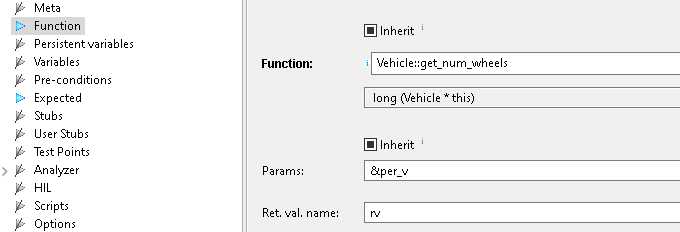
class Vehicle
{
private:
int m_num_wheels;
int m_weight;
public:
Vehicle(int num_wheels, int weight);
int get_num_wheels();
void set_weight(int w);
};
First we create a test case, which creates an object. Allocation
is done by persitent variable:

Then we call constructor in the same test case:

The object is created now and it exists as a persistent
variable per_v. If we'd like to test values of
attributes, we could add expressions in the Expected
section.
Now let's test method get_num_wheels(). Note that we
specified this parameter as address of persistent
variable per_v:

Verify the result:

It is a good practice to make test case, which declares persistent variable and calls constructor a base test case, and test cases which implement tests on the created object as derived test cases. Of course the last test case which uses the object should also delete the persistent variable. The complete tests cases shown above in YAML, which you can paste to testIDEA:
persistVars:
decl:
per_v: Vehicle
func:
- Vehicle::Vehicle
- - '&per_v'
- 4
- 1500
tests:
- imports:
persistVars:
inherit: false
persistVars:
delete:
- per_v
func:
- Vehicle::get_num_wheels
- - '&per_v'
- rv
assert:
expressions:
- rv == 4